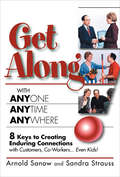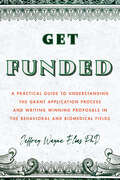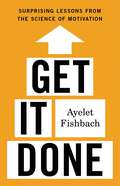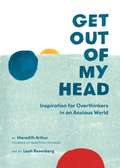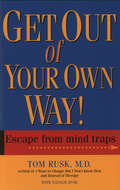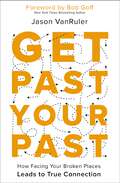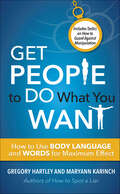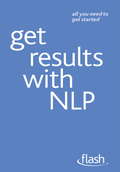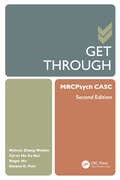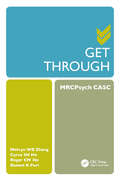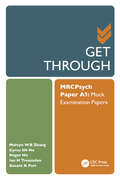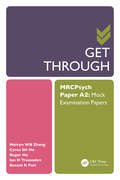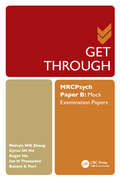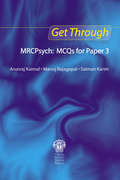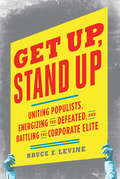- Table View
- List View
Gesundheitsmanagement für Einsteiger: Wege zur gesunden Organisation - Impulse für kleine und mittlere Unternehmen (essentials)
by Ariane BentnerAriane Bentner erläutert in diesem essential die wichtigsten Hintergrundinformationen zum Thema Gesundheitsmanagement für Arbeitgeber. Die Autorin zeigt inhaltliche Konzepte sowie Good-Practice-Beispiele für kleine und mittlere Unternehmen auf und gibt Impulse für den Aufbau eines pragmatischen Betrieblichen Gesundheitsmanagements (BGM), das zielgruppenadäquat funktionieren kann. Der demografische Wandel und der Fachkräftemangel gebieten es, die Ressource Arbeitskraft mehr denn je zu schützen. Auch kleinere Organisationen können mit wenig Aufwand passgenaue Konzepte für BGM-Maßnahmen konzipieren und anbieten.
Gesundheitsorientierte Führungskompetenz: Trainingsmanual
by Jörg Felfe Annika KrickDieses Trainingsmanual bietet alles, was Sie für das Führungskräftetraining zur Förderung gesundheitsorientierter Führungskompetenz benötigen. Als Grundlage und Ausgangspunkt dient das Health-oriented Leadership Konzept (HoL) mit dem Fokus auf gesundheitsorientierter Selbst- und Mitarbeiterführung (SelfCare und StaffCare). Das Training selbst ist modular aufgebaut und besteht aus den folgenden 5 Bausteinen:Baustein 1 „Warm up“Baustein 2 „Grundlagen”Baustein 3 “SelfCare”Baustein 4 “StaffCare” Baustein 5 “Cool down”Somit ist das Manual mit dem klaren Anwendungsbezug bestens geeignet, das Training in der Praxis direkt umzusetzen. Im Manual werden auch die Voraussetzungen und Bedingungen für die erfolgreiche Trainingsdurchführung thematisiert. Der theoretische Hintergrund des Trainings wird anschaulich dargestellt und die Konzeption des Trainings praxisnah erläutert. Zusätzlich gibt es für jedes Modul konkrete und detaillierte Traineranweisungen und das Material für die Durchführung des Trainings.
Gesundheitspsychologie: Eine Einführung – kompakt, prägnant und anwendungsorientiert (Angewandte Psychologie Kompakt)
by Peter Michael BakDieses prägnante Lehrbuch aus der Lehrbuchreihe Angewandte Psychologie Kompakt enthält die wichtigsten psychologischen Theorien und Konzepte rund um das Trendthema Gesundheitspsychologie. Es ist speziell für Studierende konzipiert, die sich einen schnellen und eingängigen Überblick über die Thematik sowie einen starken Praxisbezug wünschen. Die sorgfältige Didaktik, Klausurfragen, digitale Zusatzmaterialien und Zusammenfassungen stellen eine optimale Grundlage für das Verstehen des Lehrstoffes und die Prüfungsvorbereitung im Bereich der Gesundheitspsychologie dar. Durch zahlreiche Anwendungsbeispiele, Reflexionsfragen, eingebundene Audioclips und Online-Zusatzmaterialien ist es in einzigartiger Weise anwendungsorientiert und weckt dadurch Lust, das Gelernte gedanklich weiterzuentwickeln und in verschiedensten Kontexten umzusetzen. Zusätzlich sind Fragen und Antworten zum Selbsttest über die SN Flashcards Lern-App inkludiert. Der Zugangscode befindet sich im gedruckten Buch.
Get Along with Anyone, Anytime, Anywhere!: 8 Keys to Creating Enduring Connections with Customers, Co-Workers . . . Even Kids!
by Arnold Sanow Sandra StraussA renowned business and communication expert demonstrates 8 key ways to create enduring connections with friends, customers, co-workers . . . and even kids! Whether you work in marketing and sales or in customer service . . . are a CEO or a stay-at-home mom, the ability to effectively connect with the needs of others dramatically affects your productivity, effectiveness, and motivation. This is your one-stop guidebook for all the information you need to communicate effectively and build lasting personal and professional relationships today, next week, and next year. Relationships are critical to success and happiness. This book, written by one of only 525 Certified Speaking Professionals in the world, will give you skills you need to turn your encounters with contacts, acquaintances, and even family members, into enduring connections. "A useful reminder of what we all need to make our lives and our businesses work better: communication, openness and sincerity. It's so easy to lose touch with these concepts in a busy, stressful day, but Sanow and Strauss make a compelling argument that it's worth it to make the effort.&” —The Washington Post
Get Fit, Get Happy: A new approach to exercise that's fun and helps you feel great
by Harry JuddGet Fit, Get Happy isn't about just transforming the way you look.It's about transforming the way you feel. Harry Judd is a member of the hugely successful bands McFly and McBusted who have headlined Hyde Park, notched up 19 hit singles - of which 7 went to number one - and 2 number-one albums. He is a much-loved former Strictly Come Dancing champion and has been crowned the nation's favourite ever winner of the show.And yet in spite of this success, there have been times when Harry has been prone to anxiety and other mental health issues. He's not alone. Today, anxiety, depression and other mental health problems affect more of us than ever before and we are all looking for ways to adapt, cope and survive the pressures of daily life.The one thing that Harry has turned to time and time again to redress the balance in his life is fitness. Now, using a combination of exercise and dance, Harry makes the mood-boosting benefits of fitness accessible for everyone. Young or old, male or female, small or large, tall, short, thin, fat or somewhere in the middle: anyone will be inspired by Get Fit, Get Happy. Without any need for expensive kit or lots of time, Harry's approach is fun, fast, free. Part memoir in which Harry tells the life lessons that he has learned, and part richly researched fitness plan to get you feeling more positive, Get Fit, Get Happy is a fitness revolution to help people find a little more happiness in their lives.
Get Fit, Get Happy: A new approach to exercise that's fun and helps you feel great
by Harry JuddGet Fit, Get Happy isn't about just transforming the way you look.It's about transforming the way you feel. Harry Judd is a member of the hugely successful bands McFly and McBusted who have headlined Hyde Park, notched up 19 hit singles - of which 7 went to number one - and 2 number-one albums. He is a much-loved former Strictly Come Dancing champion and has been crowned the nation's favourite ever winner of the show.And yet in spite of this success, there have been times when Harry has been prone to anxiety and other mental health issues. He's not alone. Today, anxiety, depression and eating disorders affect more of us than ever before and we are all looking for ways to adapt, cope and survive the pressures of daily life.The one thing that Harry has turned to time and time again to redress the balance in his life is fitness. Now, using a combination of exercise and dance, Harry makes the mood-boosting benefits of fitness accessible for everyone. Young or old, male or female, small or large, tall, short, thin, fat or somewhere in the middle: anyone will be inspired by Get Fit, Get Happy. Without any need for expensive kit or lots of time, Harry's approach is fun, fast, free. Part memoir in which Harry tells the life lessons that he has learned, and part richly researched fitness plan to get you feeling more positive, Get Fit, Get Happy is a fitness revolution to help people find a little more happiness in their lives.The fully illustrated Get Fit, Get Happy Fitness Plan can be found in the accompanying PDF to this audiobook. (P)2017 Hodder & Stoughton
Get Funded: A Practical Guide to Understanding the Grant Application Process and Writing Winning Proposals in the Behavioral and Biomedical Fields
by Jeffrey Wayne EliasAn essential guide for those who wish to hone their skills in writing successful grant applications. Scientific research relies on funding, and everyone who conducts research must become adept at funding their research. This book explains how to attain the number one source of research funding: grants. Readers will learn how to prepare grant proposals, how and when to interact with funding institutions, how to interpret and respond to peer review feedback, and much more. Most importantly, they will learn how to identify and convey what makes their proposed research impactful, innovative, and achievable. Author Jeffrey Wayne Elias has an extensive career in grant funding, including 27 years in academia working on grant support and grant reviewing, plus 19 years in grant management and administration. This experience affords him a well-rounded perspective on why some applications succeed while others don&’t. Elias helps readers develop and strengthen their ability to navigate the grant application process—ultimately enabling them to achieve &“grant literacy.&”
Get It Done: Surprising Lessons from the Science of Motivation
by Ayelet FishbachDiscover a "compelling" framework for setting and achieving your goals (Carol Dweck, author of Mindset), from a psychologist on the cutting edge of motivational science. A great deal of ink has been spilled on the subject of motivating and influencing others, but what happens when the person you most want to influence is you? Setting and achieving goals for yourself—at work, at home, and in relationships—is harder than it seems. How do you know where to start? How do you carry on in the face of roadblocks and distractions? How do you decide which tasks and ambitions to prioritize when you&’re faced with more responsibilities, needs, and desires than you can keep track of? In Get It Done, psychologist and behavioral scientist Ayelet Fishbach presents a new theoretical framework for self-motivated action, explaining how to: Identify the right goalsAttack the &“middle problem&”Battle temptationsUse the help of others around youAnd so much more...With fascinating research from the field of motivation science and compelling stories of people who learned to motivate themselves, Get It Done illuminates invaluable strategies for pulling yourself in whatever direction you want to go—so you can achieve your goals while staying healthy, clearheaded, and happy.
Get It Together: Troubling Tales from the Liberal Fringe
by Jesse WattersCan the political be way too personal? What if most radical activists are trying to change their lives by changing the whole country? <p><p> When Jesse Watters set out to interview a few dozen radical activists to find out where their wild ideas came from, he discovered two things that shocked him: <p><p> First, he liked these people. <p><p> Second, their political positions were not primarily from books, teachers, or other activists. They originated in personal drama. Most of these people didn’t need legislation. They needed a therapist. <p><p> In Get It Together, the number one New York Times bestselling author and Fox News primetime host takes on Wokeism in a way no one else has. Through a series of (sometimes very) personal interviews with some of the most radical activists in the country, Watters discovers that these activists may be overlooking the most important change they need to make—within themselves. <p><p> From activists working for climate change salvation, Black supremacy, and social justice to a professional cuddler and a transwoman who identifies as a wolf, Watters shows how many well-intentioned Americans have bought into causes invented and run by people who are illogical, emotional, and ill-informed. <p><p> Through their stories, Watters uncovers common threads—childhood traumas, broken relationships, and a lack of introspection. What if the people obsessed with the end of the world are just hurting from how this one has treated them? What if that, rather than ideological disagreements, is the deeper root of our country’s political divide? <p><p> Funny, fresh, and fascinating, Get It Together is sure to spark important conversations, and to inspire us to see one another not as political opponents, but as real and broken human beings. <p> <b>New York Times Bestseller</b>
Get Me Out of Here: My Recovery from Borderline Personality Disorder
by Rachel ReilandWith astonishing honesty, this memoir reveals what mental illness looks and feels like from the inside, and how healing from borderline personality disorder is possible through intensive therapy and the support of loved ones.With astonishing honesty, this memoir, Get Me Out of Here, reveals what mental illness looks and feels like from the inside, and how healing from borderline personality disorder is possible through intensive therapy and the support of loved ones. A mother, wife, and working professional, Reiland was diagnosed with borderline personality disorder at the age of 29--a diagnosis that finally explained her explosive anger, manipulative behaviors, and self-destructive episodes including bouts of anorexia, substance abuse, and promiscuity. A truly riveting read with a hopeful message.Excerpt: "My hidden secrets were not well-concealed. The psychological profile had been right as had the books on BPD. I was manipulative, desperately clinging and prone to tantrums, explosiveness, and frantic acts of desperation when I did not feel the intimacy connection was strong enough. The tough chick loner act of self-reliance was a complete facade."
Get Out of My Head: Inspiration for Overthinkers in an Anxious World
by Meredith ArthurCalm your thoughts, navigate your stress, and understand your anxiety with this compact illustrated guide for overthinkers everywhere.Are you an overthinker? You're not alone! In a world full of deadlines, and technology, and constant stress, anxiety sometimes feels inevitable. But what if you learned to ride the wave of anxiety, instead of getting lost in it? Get Out of My Head is here to help, providing guidance and inspiration for anxious overthinkers of all sorts. This compact, illustrated book offers soothing techniques for understanding anxiety and moving through the traps of overthinking. Aimed at a modern audience looking for support and community, this beautifully illustrated guide offers a joyful, manageable way to deal with anxiety and quiet stressful thoughts through easy exercises, bite-sized takeaways, and calming visuals. Written by Meredith Arthur, founder of the popular mental health platform Beautiful Voyager, and illustrated by Leah Rosenberg, this charming alternative to technical mental health guides walks readers through the process of building awareness around anxiety, identifying triggers, moving through blocks, building healthy boundaries, and developing an arsenal of tools for thriving. With actionable tips throughout, and a special section on dealing with end-of-year anxieties, this striking volume also includes a small, saddle-stitched secondary book -- meant to act like a weighted blanket in book form for help on the go -- in a concealed internal pocket.
Get Out of Your Mind and Into Your Life: The New Acceptance and Commitment Therapy
by Steven C. Hayes Spencer SmithGet ready to take a different perspective on your problems and your life--and the way you live it. Acceptance and commitment therapy (ACT) is a new, scientifically based psychotherapy that takes a fresh look at why we suffer and even what it means to be mentally healthy. What if pain were a normal, unavoidable part of the human condition, but avoiding or trying to control painful experience were the cause of suffering and long-term problems that can devastate your quality of life? The ACT process hinges on this distinction between pain and suffering. As you work through this book, you'll learn to let go of your struggle against pain, assess your values, and then commit to acting in ways that further those values. ACT is not about fighting your pain; it's about developing a willingness to embrace every experience life has to offer. It's not about resisting your emotions; it's about feeling them completely and yet not turning your choices over to them. ACT offers you a path out of suffering by helping you choose to live your life based on what matters to you most. If you're struggling with anxiety, depression, or problem anger, this book can help--clinical trials suggest that ACT is very effective for a whole range of psychological problems.
Get Out of Your Own Way!: Escape From Mind Traps
by Natalie Rusk Tom RuskEscape from Mind Traps. The bestselling author of "I Want to Change But I Don't Know How" and "Instead of Therapy" offers a step-by-step approach to self-initiated, self-directed personal change. This book "maps out" ways for readers to look at themselves objectively and identify the defeating attitudes that are keeping them locked into problem habits, relationships, and situations.
Get Out, Get Love: What everyone should know in, and after, abusive relationships
by Craig Newman**Pre-order now and claim a £40 self-compassion programme for FREE**- Is this what they mean by abuse?- Why am I tolerating such a bad relationship? - Will I ever be able to get out and feel free?If you have ever asked yourself any of these questions, you may be, or have been, in an abusive relationship, even without realising. Every minute, more than 20 people in the UK or US are abused by their partner. Get Out, Get Love is an essential guide to the journey that anyone who is in, leaving or has left an abusive relationship must undertake. It takes the reader through three key stages - getting understanding (of the reasons we fall into abuse and why we tolerate it), getting out (escaping, breaking the cycle and staying away) and getting love (seeking closure, regaining trust and developing self love).Unlike other books on this subject, Get Out, Get Love focuses uniquely on putting control of the narrative in your hands. By helping you understand yourself better, it will show you how to embrace both growth and change, to create a future of freedom and joy. Author and psychologist Dr Craig Newman, who was himself in an abusive relationship, presents a supportive and proven recovery plan that has helped so many of his clients, and will help you, to Get Out and Get Love.Your journey starts here.**Use your receipt to claim a voucher to get free access to a 6-week self-compassion programme (usual cost, £40 - 12 months' access). Visit the Get Out Get Love website to find out more.**
Get Out, Get Love: What everyone should know in, and after, abusive relationships
by Craig Newman**Pre-order now and claim a £40 self-compassion programme for FREE**- Is this what they mean by abuse?- Why am I tolerating such a bad relationship? - Will I ever be able to get out and feel free?If you have ever asked yourself any of these questions, you may be, or have been, in an abusive relationship, even without realising. Every minute, more than 20 people in the UK or US are abused by their partner. Get Out, Get Love is an essential guide to the journey that anyone who is in, leaving or has left an abusive relationship must undertake. It takes the reader through three key stages - getting understanding (of the reasons we fall into abuse and why we tolerate it), getting out (escaping, breaking the cycle and staying away) and getting love (seeking closure, regaining trust and developing self love).Unlike other books on this subject, Get Out, Get Love focuses uniquely on putting control of the narrative in your hands. By helping you understand yourself better, it will show you how to embrace both growth and change, to create a future of freedom and joy. Author and psychologist Dr Craig Newman, who was himself in an abusive relationship, presents a supportive and proven recovery plan that has helped so many of his clients, and will help you, to Get Out and Get Love.Your journey starts here.**Use your receipt to claim a voucher to get free access to a 6-week self-compassion programme (usual cost, £40 - 12 months' access). Visit the Get Out Get Love website to find out more.**
Get Past Your Past: How Facing Your Broken Places Leads to True Connection
by Jason VanRulerYour brokenness is not the end of the story. It's time to heal.Any of us can get stuck in our struggle. Jesus came to set us free and give us life--abundant life--but while we believe it for everyone else, it's hard to accept his forgiveness and grace for ourselves. We continue in our old ways, living as one with no hope because we're afraid of failing if we try to get better.But what if brokenness--the array of behaviors and symptoms that show us that all is not as it should be with us--isn't all there is? What if we can change?As a licensed therapist and a man who's dealt with his own problems--including childhood trauma, alcohol abuse, drug use, and bouts of depression--Jason VanRuler understands what you're going through. In Get Past Your Past, he offers empathy, grace, and a hand to hold as he shares from his own places of brokenness and his professional knowledge to help you:Overcome the lie that you're the only one who struggles with brokennessLook your brokenness square in the face and take small, doable steps to overcome itFind the courage to be vulnerable about your story--all of it--and embrace the freedom that comes from sharing itLearn to love and be loved in your most cherished relationshipsCultivate authentic connection with those around you and with God The life you dream of isn't that far away. But you can't stay where you are. It's time to embark on your journey toward healing. Let Get Past Your Past be your guide along the way.
Get People to Do What You Want: How to Use Body Language and Words for Maximum Effect
by Gregory Hartley Maryann KarinchA former Army interrogator shares his secrets for getting exactly what you want out of anyone, anytime.In business, school, romance, or your neighborhood, it is valuable to know what attracts people, what repels them, and what makes them tick. Choosing the right approach will enable you to influence people to do what you want in professional and social situations. The authors include updated case studies—some pulled from the headlines—of how this technique has worked to create both good news and bad news. Most importantly and all new, they tell you how to identify and guard against manipulation so you remain in control of your choices and options.In Get People to Do What You Want, you'll learn about:•One-on-one interaction•Group dynamics•The projection of leadership•Instinctual trust and mistrust of othersGet People to Do What You Want is the perfect, modern complement to Dale Carnegie's 1937 classic work on the topic, How to Win Friends and Influence People. Think of these books as the Old and New Testaments of persuasion.
Get Results with NLP: Flash
by Alice MuirThe books in this bite-sized new series contain no complicated techniques or tricky materials, making them ideal for the busy, the time-pressured or the merely curious. Get Results with NLP is a short, simple and to-the-point guide to learning some basic NLP techniques to improve your powers of persuasion and boost your charisma. Whether you want to be more successful at work, be more influential in your social life, or just communicate better, in just 96 pages readers will discover a complete toolkit for making positive and lasting changes. Get Results with NLP is a quick, to-the-point guide for those who want to make instant changes to their life in the quickest time possible.
Get Through MRCPsych CASC (Get Through)
by Roger Ho Basant K. Puri Melvyn Zhang Weibin Cyrus Ho Su HuiGet Through MRCPsych CASC, Second Edition is intended for psychiatric trainees sitting the CASC component of the MRCPsych exam. Written by authors with recent exam experience and long-term expertise in the field, the text provides over 100 stations closely matched to the subjects that appear in the actual exam, along with informative diagrams, concise synopses, and guidelines for how to target your revision to enable recall of the most relevant information. *Gives a detailed appraisal of how to approach over 100 stations for the CASC component of the examination *Shares the guidance of experts in Psychiatry and Medical Education *Builds on a successful first edition with tips on pitfalls
Get Through MRCPsych CASC: Mock Examination Papers (Get Through)
by Melvyn W. Zhang Cyrus S. Ho Roger C. Ho Basant K. PuriThis book is intended for psychiatric trainees sitting the CASC component of the MRCPsych exam. Written by authors with recent exam experience and long-term expertise in the field, the text provides 175 stations closely matched to the subjects that appear in the actual exam, along with concise synopses and guidelines for how to target your revision to enable recall of the most relevant information.
Get Through MRCPsych Paper A1: Mock Examination Papers (Get Through)
by Roger Ho Ian H Treasaden Basant K Puri Melvyn Wb Zhang Cyrus Sh HoThe MRCPsych examinations, conducted by the Royal College of Psychiatrists are the most important exams for psychiatric trainee to achieve specialist accreditation. <P><P>Written by authors with previous exam experience and edited by the distinguished team behind Revision Notes in Psychiatry, Get Through MRCPsych Paper A: Mock Examination Papers provides candidates with the most realistic and up-to-date MCQ and EMIs, closely matched to themes appearing most often in the Paper A exam.
Get Through MRCPsych Paper A2: Mock Examination Papers
by Roger Ho Ian H Treasaden Basant K Puri Melvyn Wb Zhang Cyrus Sh HoThe MRCPsych examinations, conducted by the Royal College of Psychiatrists are the most important exams for psychiatric trainee to achieve specialist accreditation. Written by authors with previous exam experience and edited by the distinguished team behind Revision Notes in Psychiatry, Get Through MRCPsych Paper A: Mock Examination Papers provides candidates with the most realistic and up-to-date MCQ and EMIs, closely matched to themes appearing most often in the Paper A exam.
Get Through MRCPsych Paper B: Mock Examination Papers (Get Through Ser.)
by Melvyn WB Zhang Cyrus SH Ho Ian H Treasaden Basant K Puri Roger CM HoThe MRCPsych examinations, conducted by the Royal College of Psychiatrists, are the most important exams for psychiatric trainees to achieve specialist accreditation. Written by authors with recent exam success and edited by the distinguished team behind Revision Notes in Psychiatry, Get Through MRCPsych Paper B: Mock Examination Papers provides candidates with the most realistic and up-to-date MCQ and EMIs, closely matched to themes appearing most often in the Paper B exam.
Get Through MRCPsych: MCQs for Paper 3 (Get Through)
by Arunraj Kaimal Manoj Rajagopal Salman KarimCompletely up to date with the latest examination changes, Get Through MRCPsych: MCQs for Paper 3 contains over 380 'best answer 1 of 5' multiple choice questions (MCQs) presented in a format closely matching the new syllabus. Modelled on actual exam questions so that they accurately reflect the style and level of difficulty, candidates can te
Get Up, Stand Up: Uniting Populists, Energizing the Defeated, and Battling the Corporate Elite
by Bruce E. Levine"Are Americans a Broken People?" Levine, a practicing clinical psychologist and frequent writer on political matters, asked in a 2009 web article, meditating on the problem of American political passivity in the face of attacks on their liberties and their economic well-being. In this work, he expands on that article, exploring the cultural and psychological reasons many Americans feel politically demoralized and considering the means of regaining the individual self-respect and collective self-confidence that are prerequisites for building mass democratic politics (based on a populism transcending right/left divisions) that can overcome the current control of the American political system by elites. Annotation ©2011 Book News, Inc. , Portland, OR (booknews. com)



